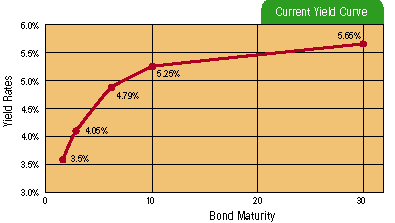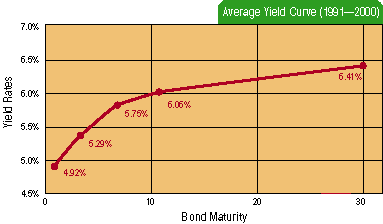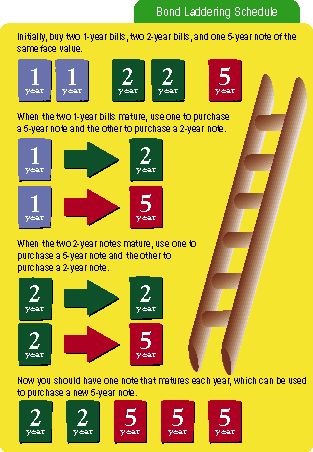
HOT TOPICS LIST
- Strategies
- Stocks
- Buy
- Investing
- Brokers
- Psychology
- Interviews
- Accumulate
- Sell
- Hold
- Spotlight
- Websites
- Candlestick Corner
- Gold & Metals
- Options Trading
LIST OF TOPICS
MONEY MANAGEMENT
Bond Laddering
08/12/01 05:16:02 PM PSTby Han Kim
It's a good idea to keep a portion of your portfolio in bonds because of their relative safety. But you can reduce the small risk of bonds even further.
Investors choose bonds with the intention of keeping their investments in a safe place. Bonds can be used to offset or hedge some higher-risk investments or be used for for an entire retirement nest egg -- when knowing how much you have and when you will have the money you desire is the investor's goal. Whichever way you go, bonds have typically been considered a safe haven for investors. Although they are considered safe, there are variations in risk among different types of bonds. To start with, a bond is a long-term debt security with a stated interest rate and fixed due dates (also known as maturity dates). It differs from shares of stock, which is basically ownership in the company issuing the stock. A bond with a longer maturity date (a date farther in the future) will pay a higher interest than one that matures sooner. But along with this higher interest comes higher risk. When interest rates rise, bond prices decline. Conversely, when interest rates fall, bond prices rise. Interest rates are difficult to predict. If your goal is to beat the effects of inflation with your investments, but if you don't have much tolerance for risk, then bond laddering might be something you want to consider. WHAT IS IT?Bond laddering is a technique that involves purchasing several debt instruments with varying maturity dates, so that you can have income streaming in at a steady rate from one bond or another every year. For example, if you wish to build a five-year bond ladder, you would purchase bonds (or debt instruments) that mature in one, two, three, four, and five years, respectively. When your one-year bond matures, you would promptly reinvest the proceeds in another five-year bond, to mature in five years. In order to have the flexibility to access your money if necessary, you should purchase shorter-term debt instruments as opposed to 30-year bonds. This gives you a continuous stream of income each year. Since short-term debt instruments such as one-year US Treasury bills and two-year Treasury notes do not lock up your money for long periods, they give you the flexibility to use your money as need arises or to purchase other bonds in a relatively short time. However, they usually have lower yields (Figure 1). Long-term debt instruments such as 30-year bonds may give you higher yields, but 30 years is a long time to keep your money in one place, especially when the yield rates fluctuate. A five-year T-note gives the investor the flexibility to reinvest in a short period while reaping higher yields that shorter-term bonds often do not provide.
 FIGURE 1: CURRENT YIELD CURVE. As bond maturity dates become more distant, the higher the yield becomes. This is expected, since you are taking on more risk by putting your money into a longer-term investment. Although there are many types of bonds, issued by corporations and governments, I will only deal with US Treasury bonds as an example. (However, the strategies discussed here can be applied to other bonds as well.) As far as Treasuries go, the five-year notes (see sidebar, "Treasury nomenclature") are probably the best for bond laddering. The average year-end yield for a five-year Treasury note for the last decade (1991?2000) has been about 5.75% per year (Figure 2) -- not too shabby for an investment guaranteed by the US government to be almost risk-free.  FIGURE 2: AVERAGE YIELD CURVE. Over the past decade (1991-2000), the average yields for bonds have been as shown. A five-year note's rate is competitive versus the longer-term bonds, but with much shorter maturity. ONE RUNG AT A TIME: IT'S SIMPLEInvestors have a lot of flexibility when it comes to building a bond ladder. You have to decide how long your ladder will be, what securities to use, and when they should mature. Figure 3 is an example of a bond laddering strategy that could work for you.  FIGURE 3: BOND LADDERING SCHEDULE. Initially, you start with various types of bonds. Then, as the bonds mature, you roll them over into varying periods until you have a complete bond ladder. Each initial bond purchased is color-coded here, so you can keep track of how the bond moves each year. To build a bond ladder, initially buy two one-year bills, two two-year notes, and one five-year note, all with the same face value. When the two one-year bills mature, use one to purchase a five-year note and one to purchase a two-year note. When the two two-year notes mature, use one to purchase a five-year note and one to purchase a two-year note. Now you should have one bond that matures each year, which in turn can be used to purchase a new five-year note. And that's it! SUMMARYSetting up a bond ladder is simple, and it allows you to have a constant stream of income with returns that are more stable than if you were purchasing these bonds individually. How? For instance, if interest rates were to decline, you would be exposing only a percentage of your fixed-income investments to this lower interest rate. Bonds that were purchased earlier would still be earning the higher interest rate. Similarly, you can take advantage of higher interest rates by reinvesting those bonds that mature. The downside is that purchasing individual bonds can be expensive. If you have money to invest in bonds, using a laddering strategy will guarantee income on a regular basis and you wonOt be exposing all your fixed-income investments to the mercy of interest rate fluctuations. Han Kim may be reached at HKim@Traders.com. Current and past articles from Working Money, The Investors' Magazine, can be found at Working-Money.com. SIDEBARUS Treasury nomenclature
|
Staff Writer
| Title: | Webmaster |
| Company: | Technical Analysis, Inc. |
| Address: | 4757 California AVE SW |
| Seattle, WA 98116 | |
| Phone # for sales: | 206-938-0570 |
| Fax: | 206-938-1307 |
| Website: | working-money.com |
| E-mail address: | hkim@traders.com |
Traders' Resource Links | |
| Charting the Stock Market: The Wyckoff Method -- Books | |
| Working-Money.com -- Online Trading Services | |
| Traders.com Advantage -- Online Trading Services | |
| Technical Analysis of Stocks & Commodities -- Publications and Newsletters | |
| Working Money, at Working-Money.com -- Publications and Newsletters | |
| Traders.com Advantage -- Publications and Newsletters | |
| Professional Traders Starter Kit -- Software | |
PRINT THIS ARTICLE

|

Request Information From Our Sponsors
- StockCharts.com, Inc.
- Candle Patterns
- Candlestick Charting Explained
- Intermarket Technical Analysis
- John Murphy on Chart Analysis
- John Murphy's Chart Pattern Recognition
- John Murphy's Market Message
- MurphyExplainsMarketAnalysis-Intermarket Analysis
- MurphyExplainsMarketAnalysis-Visual Analysis
- StockCharts.com
- Technical Analysis of the Financial Markets
- The Visual Investor
- VectorVest, Inc.
- Executive Premier Workshop
- One-Day Options Course
- OptionsPro
- Retirement Income Workshop
- Sure-Fire Trading Systems (VectorVest, Inc.)
- Trading as a Business Workshop
- VectorVest 7 EOD
- VectorVest 7 RealTime/IntraDay
- VectorVest AutoTester
- VectorVest Educational Services
- VectorVest OnLine
- VectorVest Options Analyzer
- VectorVest ProGraphics v6.0
- VectorVest ProTrader 7
- VectorVest RealTime Derby Tool
- VectorVest Simulator
- VectorVest Variator
- VectorVest Watchdog
